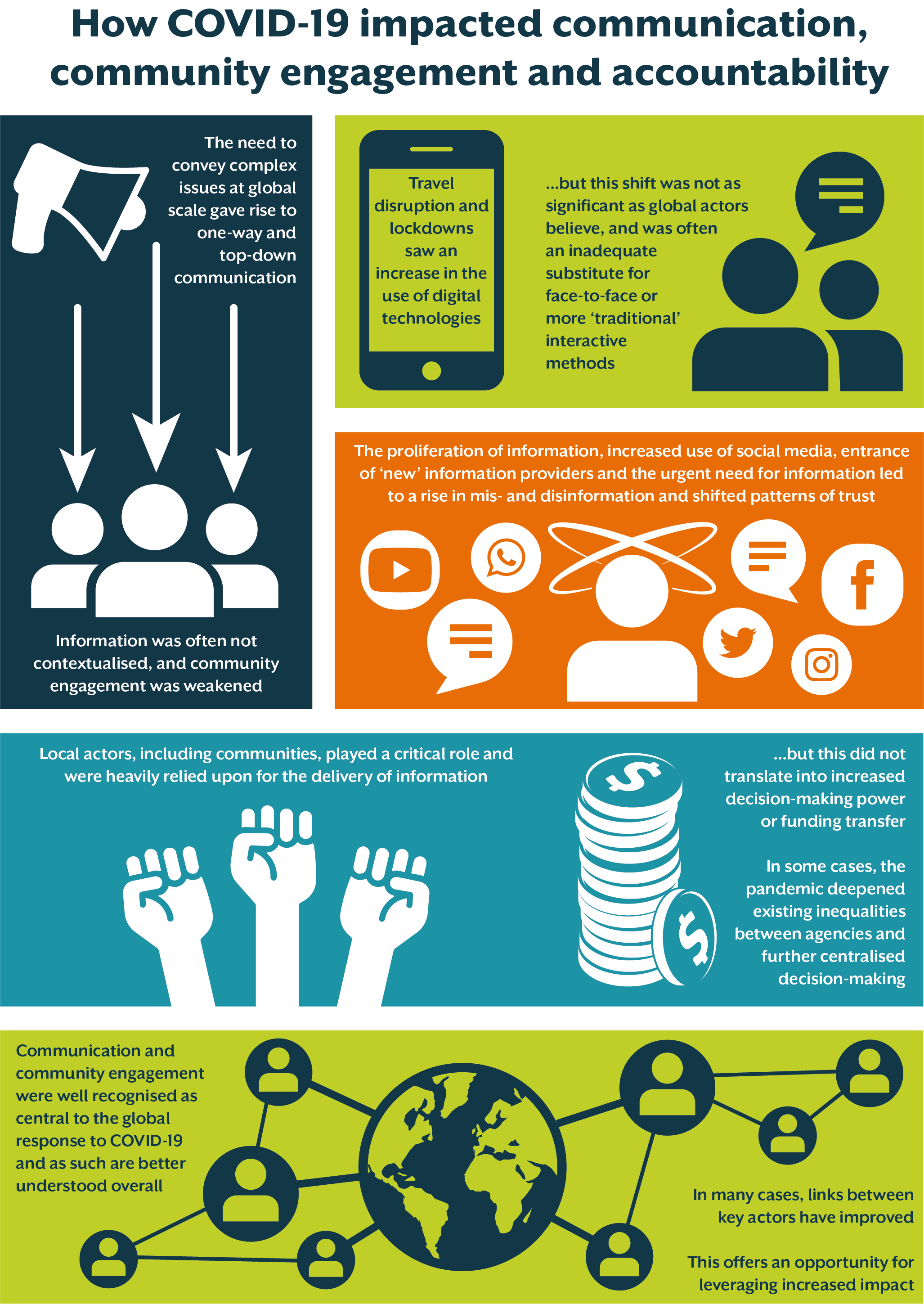The impact of COVID-19 on communication, community engagement and accountability: perspectives from stakeholders, communicators and audiences
The COVID-19 pandemic has shaped humanitarian discourse and action since early 2020. It shone a spotlight on the critical importance of effective dialogue and communication, on the need for accurate and informed information, and the value of engagement in developing communication that ensures access by all affected.
This study sought to identify changes to the communication, community engagement and accountability (CCEA) landscape as a result of the COVID-19 pandemic. Five key trends were identified and recommendations offered for forward planning.
Key findings and recommendations
The pandemic dominated information flows throughout 2020–2021. The prioritisation of the need to convey complex issues rapidly and at global scale gave rise to one-way and top-down communication. In many cases, this meant information was not contextualised, or necessarily communicated in the appropriate language, people were often excluded and the message was less effective. Community engagement was weakened, and this affected the prioritisation of key messages and programmatic communication aims.
Recommendations:
Ensure coordination is context appropriate, inclusive and well communicated. Where coordination was understood, common information sharing and messaging was reported as more appropriate.
Focus on long term investment in systems, relationships and structures. Ensuring that the right people are involved in curating and disseminating information and effectively engaging people at the right time can amplify successful CCEA.
Travel disruption and widespread lockdowns saw an increase in the use of digital technologies, but this shift was not as significant as global actors believed and was often an inadequate substitute for face-to-face or more ‘traditional’ interactive methods.
Recommendations:
Digital and technology approaches must take into account the diverse capacity and demands of its stakeholders. Design should take an audience-centred approach and be complemented by alternative, non-digital methods to ensure inclusion.
Invest in ways to better integrate legacy and community media. Given the importance of radio and other methods of communication, a focus on partnership and capacity will ensure such actors are not overlooked.
Understand data risks associated with increased reliance on digital technology. Those working in the sector should understand how these risks can affect personnel, organisations and beneficiaries, and work to mitigate these risks.
The proliferation of information, the entrance of ‘new’ information providers and an urgent need for information led to a rise in mis- and disinformation and shifted patterns of trust. Mis- and disinformation on COVID-19 is rife, and the increased engagement in social media has led to an increase in misinformation overall.
Recommendations:
Mis- and disinformation require concerted and context wide focus. Successful examples include a holistic and multi-faceted approach using technology, capacity-building and media literacy efforts all have a role to play. Better understanding is required in this.
Trust is a critical determinant of effective CCEA. Investment is needed in understanding community trusted sources. It is easy for international actors to make the wrong assumptions on trust.
Local actors, including communities, played a critical role and were heavily relied upon for the delivery of information. But this does not appear to have translated into increased decision-making power or funding transfer. In some cases, the COVID-19 pandemic has deepened existing inequalities between agencies and has further centralised decision-making.
Recommendations:
Efforts to make partnership more meaningful need to consider incentives and access requirements.
Greater investment is needed in community structures for engagement. Typically chronically underfunded, this investment may have yielded more immediate impact and would have supported community engagement in decision making.
Communication and engagement was well recognised as central to the global response to COVID-19 and as such is better understood overall. In many cases, linkages between key actors have improved and offer an opportunity for leveraging increased impact. Actors need to come together to put communities first and avoid fragmenting a central issue to response.
Recommendations:
Develop a common funding ask for donors, focused on people-centred and community led CCEA. Ensuring that a funding ask focuses on demand, need and capability at community level avoids investment leaning to a specific entity or crisis.
Invest in further research. In order to improve engagement by communities in decision-making, research that focuses on better understanding trust, communication and existing systems is critical.


